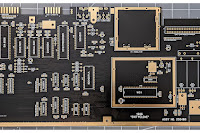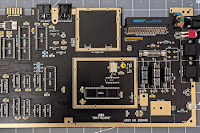When I heard in July 2020 there was finally a comet visible in the night sky it really was a photographic opportunity I didn't want to miss. Comet C/2020 F3 (NEOWISE) or as it was known to everyone, Comet Neowise, was the first comet to make a naked eye appearance in the northern Hemisphere in a long time. The last comet I'd seen was Hale Bopp in 1995 and I was very excited to repeat the experience, this time with some half decent camera gear. With a little bit of astrophotography experience under my belt I felt this was something I should be able to do, but what I didn't expect (and really should have) were the particular challenges my northern latitude, my town's light pollution, and the Scottish weather would combine to create.
As pictures obtained from other photographers across the word started to flood social media channels, my hopes were high. All of these gave me the impression of a bright, easily visible object and fuelled my enthusiasm significantly. All I really had to do was wait for a clear night, look to the north and I should be able to see it hanging about 15 degrees above the horizon. Simple right? Well, no. Not really.
So, before we get into this, I should spend a moment explaining what a comet actually is. NASA describes a comet thus: "Comets are cosmic snowballs of frozen gases, rock and dust that orbit the Sun." There really isn't much more to it. They are remnants left over from the formation of the solar system and like asteroids and the planets they orbit the sun. However, if these "cosmic snowballs" just sat in circular objects, like the planets do, we would never be aware of their presence - they're far too small to see with the naked eye. Rather, something has disrupted their orbit and caused them to drift towards the sun. As they get closer to the sun, they start to warm up and as they warm the ice melts and leaves a trail of vapour and dust - this is called "outgassing". Some of these comets are pulled straight into the sun and are never seen again, yet more are literally pulled apart as they get close to the sun and these too, amount to nothing, but just occasionally one will survive its close approach to the sun. The Sun's gravity will slingshot the comet around and back out towards the outer solar system and in the process light up all that gas and dust that has outgassed, and this is what we see as a comet - not the chunk of ice itself, that remains far to small to see, but rather the illuminated gas and dust being melted off its surface. Most of the time even these comets remain too faint to see without telescopes. However, just sometimes some will put on a great show and be visible with the naked eye. And so it was with Comet Neowise. A visible comet is a very rare event and as such, I really didn't want to miss it.
So, how do we photograph a comet? Well in principle it should be reasonably straightforward. Although the comet is moving at a fair clip (Neowise was travelling at 17,500 miles per hour), from our point of view on earth its apparent motion in the sky is not much different from the speed that the stars seem to move and so the usual rules of regular astrophotography apply. I go into that in far more depth in this article. Suffice to say at the focal length I intended to use, I figured my exposure times would be no longer than about 5 seconds, less if possible, with an ISO of about 1600, less if possible, and the widest aperture my lenses would allow. Obviously a tripod would be a must. In the end I gravitated between 4 and 8 seconds, ISO 400 to 800 and f/4.
I set myself a couple of goals. Firstly, I just wanted to see it. Secondly, just get a straightforward picture of it and with that in the bag, only then try to set up an interesting foreground.
My first opportunity to see the comet came early in the morning of Sunday 12th July. Up until then we had been completely and frustratingly clouded out. What astonished me was how bright the northern sky was at 1.30 am. It was so bright in fact that even though I was quite some way from streetlights, I could see surprisingly well without my head-torch. This also gave me significant problems simply trying to locate the comet in the sky. Using apps on my phone I was able to determine where the comet was supposed to be but I absolutely could not see it with my naked eye. An 8 seconds exposure pointing exactly north at 24mm revealed it, however any attempt to enhance the brightness of the comet by upping the ISO simply enhanced the brightness of the northern sky too. There was no way I could think of to get the picture I wanted in camera and so I had no option but to contemplate fixing it in post-processing: reducing the brightness of the horizon and darkening the sky above but ensuring the comet and few stars I could see remained essentially white.
I was reasonably fortunate in that where I had chosen there were a few boats on the shoreline which made a somewhat interesting foreground. However, I had initially wanted to take 30 or 40 pictures of the whole scene and stack them to enhance available detail however some moving clouds and moving boats in the tide buggered this idea too. It became readily apparent stacking wasn't going to be an option so everything was going to have to be captured in one picture. Focus stacking proved quite nasty too as I really struggled to get accurate focus on the boats in the foreground which were pretty much in shadow below the very bright horizon.
By now, whether it was my eyes having adjusted to the ambient light or whether it had in fact got slightly darker I could just about make out the faintest smudge that was indeed Comet Neowise. It bore no resemblance at all to the bright clear pictures I had seen on social media, so either these bad been heavily edited or they were taken in much darker conditions than I found myself in.
My last and final issue was that on the second weekend I managed to get out and see Neowise (18th July) it was higher above the horizon. This meant I had to reduce my focal length in order to include both it and my foreground, which in turn reduced the size, and thus impact, of the comet in the image.
I'm well aware these all sound like desperate excuses but I have seen relatively few pictures of the comet taken from Scotland and I do wonder if being that bit further north has made it problematic for some? Certainly unless you knew exactly where to look it was extraordinary difficult to discern and from my location, without a camera and a long exposure I very much doubt you would ever have seen it.
None of this put me off however, I had great fun fighting all of these issues and am perfectly happy that I came away with any pictures at all. Three of my efforts, taken over the course of two weekends are here and though far from perfect, I've had a blast. Neowise won't return for 6800 years but I do hope there's another in my lifetime, to the south preferably, and in winter.
 |
| 8 Seconds, f/4, ISO 800 |
 |
| 6 Seconds, f/4, ISO 400 |
 |
| 4 Seconds, f/4, ISO 400 |




